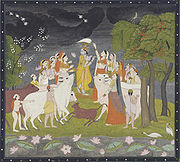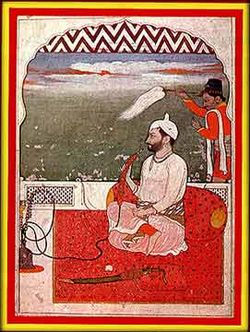
Kangra paintings
Encyclopedia

Himachal Pradesh
Himachal Pradesh is a state in Northern India. It is spread over , and is bordered by the Indian states of Jammu and Kashmir on the north, Punjab on the west and south-west, Haryana and Uttar Pradesh on the south, Uttarakhand on the south-east and by the Tibet Autonomous Region on the east...
, a former princely state, which patronized the art. It became prevalent with the fading of Basohli school of painting in mid-18th century , and soon produced such a magnitude in paintings both in content as well as volume, that the Pahari painting
Pahari painting
Pahari painting is an umbrella term used for a form of Indian painting, originating from Himalayan Hill kingdoms of North India, during 17th-19th century...
school, came to be known as Kangra paintings .
Though the main centre of Kangra paintings are Guler
Haripur Guler
Haripur is a township in Kangra district in the Indian state of Himachal Pradesh. Haripur Guler are twin townships carrying the heritage of Guler Riyasat...
, Basohli, Chamba
Chamba, Himachal Pradesh
Chamba is an ancient town in the Chamba district in the state of Himachal Pradesh, in northern India. According to the 2001 Indian census, Chamba has a population of 20,312 people...
, Nurpur
Nurpur
Nurpur is a city and a municipal council in Kangra district in the Indian state of Himachal Pradesh. It was formerly a Kingdom ruled by the Pathania clan of Rajputs, since the 11th century AD. The capital of the Kingdom was at Pathankot, now in Punjab....
, Bilaspur
Bilaspur, Himachal Pradesh
Bilaspur is a city and a municipal council in Bilaspur district in the state of Himachal Pradesh, India.-Geography:Bilaspur is located at . It has an average elevation of 673 metres . It is hot in summer and cold in winters. It rains mostly in July to august .It lies near the reservoir of...
and Kangra. Later on this style also reached Mandi, Suket, Kulu, Arki, Nalagarh
Nalagarh
#REDIRECT Target page nameNalagarh is a city and a municipal committee in Solan district in the Indian state of Himachal Pradesh. It was the seat of the eponymous princely state during the British Raj, and known in medieval period as the state of Hindur. It was founded by the Chandella Rajputs in...
and Tehri Garhwal (represented by Mola Ram
Mola Ram
Mola Ram was an Indian painter, who originated the Garhwal branch of the Kangra school of painting. He was born in Srinagar , and worked for the Garhwal Kingdom from 1777 until its annexation in 1803. He was also a poet, historian and diplomat...
), and now are collectively known as Pahari painting
Pahari painting
Pahari painting is an umbrella term used for a form of Indian painting, originating from Himalayan Hill kingdoms of North India, during 17th-19th century...
.
Pahari paintings, as the name suggests, were paintings executed in the hilly regions of India, in the sub-Himalayan state of Himachal Pradesh
Himachal Pradesh
Himachal Pradesh is a state in Northern India. It is spread over , and is bordered by the Indian states of Jammu and Kashmir on the north, Punjab on the west and south-west, Haryana and Uttar Pradesh on the south, Uttarakhand on the south-east and by the Tibet Autonomous Region on the east...
. It is in the development and modification of Pahari paintings, that the Kangra School features. Under the patronage of Maharaja Sansar Chand (c.1765-1823), it became the most important center of Pahari painting.
Kangra paintings belong to the school of Pahari painting
Pahari painting
Pahari painting is an umbrella term used for a form of Indian painting, originating from Himalayan Hill kingdoms of North India, during 17th-19th century...
s that were patronized by the Rajput
Rajput
A Rajput is a member of one of the patrilineal clans of western, central, northern India and in some parts of Pakistan. Rajputs are descendants of one of the major ruling warrior classes in the Indian subcontinent, particularly North India...
rulers between the 17th and 19th centuries.
Learn the art: Kangra Miniature Paintings can currently be studied at the Chitera School of Art, Dharamshala.
History

Haripur Guler
Haripur is a township in Kangra district in the Indian state of Himachal Pradesh. Haripur Guler are twin townships carrying the heritage of Guler Riyasat...
’ in the Lower Himalayas in the first half of the 18th century when a family of Kashmiri painters trained in Mughal painting
Mughal painting
Mughal painting is a particular style of South Asian painting, generally confined to miniatures either as book illustrations or as single works to be kept in albums, which emerged from Persian miniature painting, with Indian Hindu, Jain, and Buddhist influences, and developed largely in the court...
Style sought shelter at the court of Raja Dalip Singh (r. 1695-1741) of Guler. The rise of Guler Paintings started in what is known as the Early phase of Kangra Kalam. The new arrivals mingled with the local artists and were greatly influenced by the atmosphere of the hills. Instead of painting flattering portraits of their masters and love scenes, the artistes adopted themes of eternal love between Radha and Krishna. The paintings were naturalistic and employed cool, fresh colors. The colors were extracted from minerals, vegetables and possessed enamel-like luster. Verdant greenery of the landscape, brooks, springs were the recurrent images on the miniatures.
This style reached its zenith during the reign of Maharaja Sansar Chand Katoch (r.1776-1824) who was a great patron of Kangra art. Being a liberal patron, the painters working at his atelier received large commissions while others accepted a permanent settlement in the form of lands. Maharaja Sansar Chand was an ardent devotee of Krishna and used to commission artists to paint subjects based on the loves and life of Krishna.
The Guler-Kangra art is the art of drawing and the drawing is precise and fluid, lyrical and naturalistic. In these styles the faces are well modelled and shaded so judiciously that they possess almost porcelain-like delicacy.
Themes
The focal theme of Kangra painting is Shringar (the erotic sentiment). The subjects seen in Kangra painting exhibit the taste and the traits of the life style of the society of that period. BhaktiBhakti
In Hinduism Bhakti is religious devotion in the form of active involvement of a devotee in worship of the divine.Within monotheistic Hinduism, it is the love felt by the worshipper towards the personal God, a concept expressed in Hindu theology as Svayam Bhagavan.Bhakti can be used of either...
cult was the driving force and the love story of Radha
Radha
Radha , also called Radhika, Radharani and Radhikarani, is the childhood friend and lover of Krishna in the Bhagavata Purana, and the Gita Govinda of the Vaisnava traditions of Hinduism...
and Krishna
Krishna
Krishna is a central figure of Hinduism and is traditionally attributed the authorship of the Bhagavad Gita. He is the supreme Being and considered in some monotheistic traditions as an Avatar of Vishnu...
was the main source of spiritual experience, which was also the base for the visual expression. Bhagvata Purana and the love poems Gita Govinda
Gita Govinda
The Gita Govinda is a work composed by the 12th-century poet, Jayadeva, who was born in Kenduli Sasan near Puri in Orissa. It describes the relationship between Krishna and the gopis of Vrindavana, and in particular one gopi named Radha...
of Jaidev
Jaidev
Jaidev Hindi:जयदेव वर्मा , was a music composer in Bollywood films, most known for his work in films: Hum Dono , Reshma Aur Shera , Prem Parbat and Gharonda ....
were the most popular subjects dealing with the legends and the amorous plays of Radha and Krishna symbolising soul’s devotion to God. In some miniatures, the blue-god Krishna is seen dancing in the lush woodlands and every maiden’s eye are drawn to him. Krishna subjects, known commonly as Krishna-lila predominate, while the themes of love, inspired by the nayaks and nayikas and baramasa enjoyed great favour. The sentiment of love remained the inspiration and the central theme of Pahari painting. The Sat Sai depictions of the legendary lovers, on the other hand, were set against an architectural background with walls, balconies and windows. Kangra paintings influenced by the Bhagavad Purana portrayed incidents from the life of the young Krishna, against the Brindavan forest or river Yamuna. The other popular themes were the stories of Nala and Damayanti, and those from Keshavdas's Baramasa.
Features of Kangra painting

The Kangra artists adopted various shades of the primary colors and used delicate and fresher hues. For instance, they used a light pink on the upper hills to indicate distance.
Kangra paintings depict the feminine charm in a very graceful manner. Facial features are soft and refined. The female figures are exceptionally beautiful.
Later Kangra paintings also depicted nocturnal scenes, and storms and lightning. The paintings were often large and had complex compositions of many figures and elaborate landscapes. Towns and house clusters were often depicted in the distance.
The Kangra painters used colors made of vegetable and mineral extracts. They employed cool and fresh colors. Kangra paintings are known for the lyrical blending of form and color.
The Kangra Arts Promotion Society(http://www.kangraarts.org) an NGO at Dharamshala Himachal Pradesh is working for the promotion of this art which is at the verge of extinction today. This NGO is running a school to train young boys and girls in this art. It also runs a workshop where genuine Kangra Paintings are made on traditional hand made paper using only mineral and vegetable colours.
Further reading
- Kangra Painting, by William George Archer. Published by Faber and Faber, 1956.
- Centres of Pahari Painting, by Chandramani Singh. Published by Abhinav Publications, 1982. ISBN 0391024124.
- Kangra Paintings on Love, by M S Randhawa. Publications Division. 1994. ISBN 8123000502.

